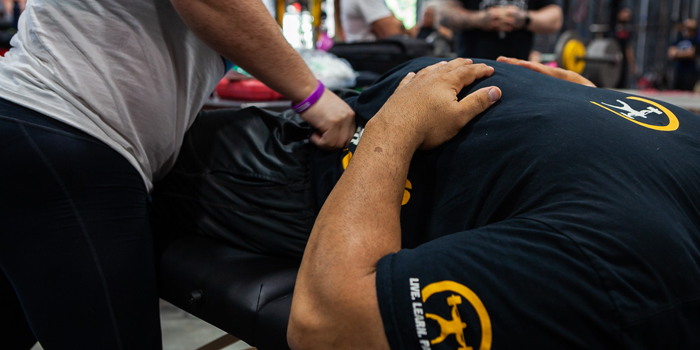
Femoro-acetabular impingement (FAI) is a common injury where extreme ranges of hip internal rotation or extension are reached and can be found frequently in athletes, whether it is symptomatic or asymptomatic. The mechanism of FAI is an abnormal tear on the labrum within the acetabulum of the pelvis surrounding the head of the femur.
Tears in the labrum generally occur with an abnormally shaped femoral head or pelvis. The angle from the shaft of the femur to the neck of the femur is optimally between 120 and 135 degrees. However, FAI often occurs during coxa vara neck/shaft angles, where the angle of the neck/shaft is smaller than 120 degrees, or coxa valga neck/shaft angles, where the angle of the neck/shaft is more than 135 degrees. (1)
RECENT: The Single, The Heavy Single and the 1RM: Know the Difference
However, FAI can also occur in normally shaped structures, generally, if the person partakes in regular activities requiring extreme ranges of movement in the hip, specifically through extension and internal rotation. The mechanism of FAI can be cam, pincer, or a combination of both, depending on what is the cause of the tear.
Mechanism of Cam and Pincer Impingements
Cam impingement is where the head/neck of the femur is shaped abnormally and juts into the labrum, eventually causing tears on the femoral side. Cam impingement happens far more frequently in young active males who partake in sports where extreme ranges of internal rotation or extension are needed. (2)
Pincer impingement is caused by the over coverage of the femoral head/neck complex by the labrum. During this type of impingement, the labrum will exceed the length needed to cover the acetabulum throughout hip flexion and will essentially be crushed between the acetabular rim and the femoral neck. Pincer impingement was originally thought to be found more frequently in middle-aged women, but recent research (8) has debated that pincer impingement is quite equally common among males and females. In addition to hereditary reasons, pincer impingement can often occur due to pelvic rotation caused by spinal deformities such as scoliosis or an extreme kyphosis. (2)
However, both types of impingement are not mutually exclusive, it is commonly seen that following Magnetic Resonance Imaging (MRI), a patient can have both cam and pincer impingements within the same hip. However, the reason and the rate of occurrence of mixed cam and pincer impingements are debated topics among practitioners and researchers. It has been proposed that the deepness of the hip socket is a large determinant in the outcome of which impingement will be present. As researched in 2010 (3), a deeper hip socket (coxa valga) will more likely predispose a hip to pincer impingement, whereas a shallower hip socket (coxa vara) will more likely predispose a hip to cam impingement.
Diagnostic Procedures and FAI
An MRI is the most accurate way of diagnosing FAI for the obvious reason of obtaining visual feedback. However, given the expense and difficulty involved in getting the procedure done, one may prefer to do one or more simple quick tests to diagnose FAI.
Commonly used methods of diagnosing FAI include the Thomas Test, evaluating one’s gait cycle, the Ober’s Test (a test of IT band tightness, which its significance will be further highlighted in Part 2) and most importantly, the FADDIR Test.
The Thomas Test is a test that will test for capsular restrictions in the front of the hip and assess hip flexor tightness. The Thomas Test is performed when the client is lying on their back on a bed with their lower leg (knee and below) hanging off of the bed. From this position, the patient will pull the non-tested leg to max hip flexion. The test is positive for hip flexor tightness if the client is unable to stay in hip extension with their extended leg while in this position. The Thomas Test can be a useful tool in the diagnosis of FAI but should not be a standalone test in the diagnosis of FAI. See reference 5 for further information.
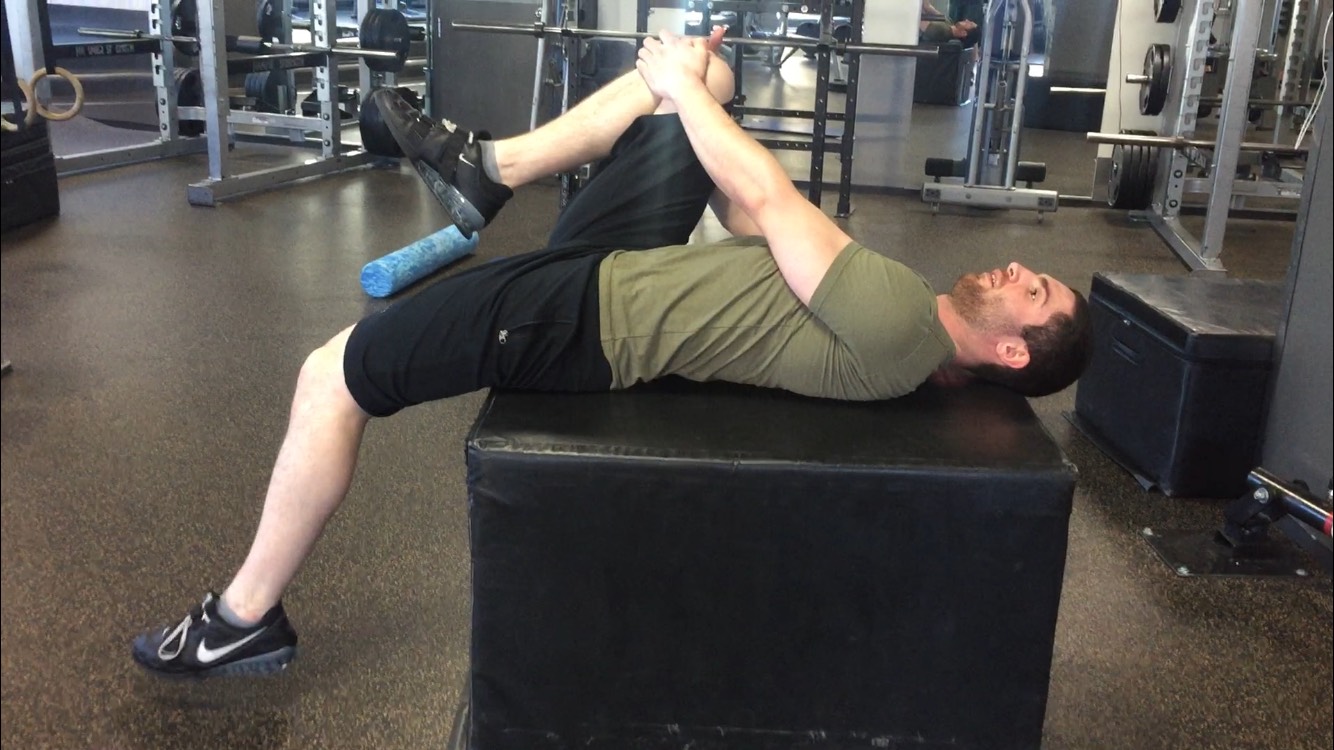
Picture of the Thomas Test — Negative for PSOAS tightness.
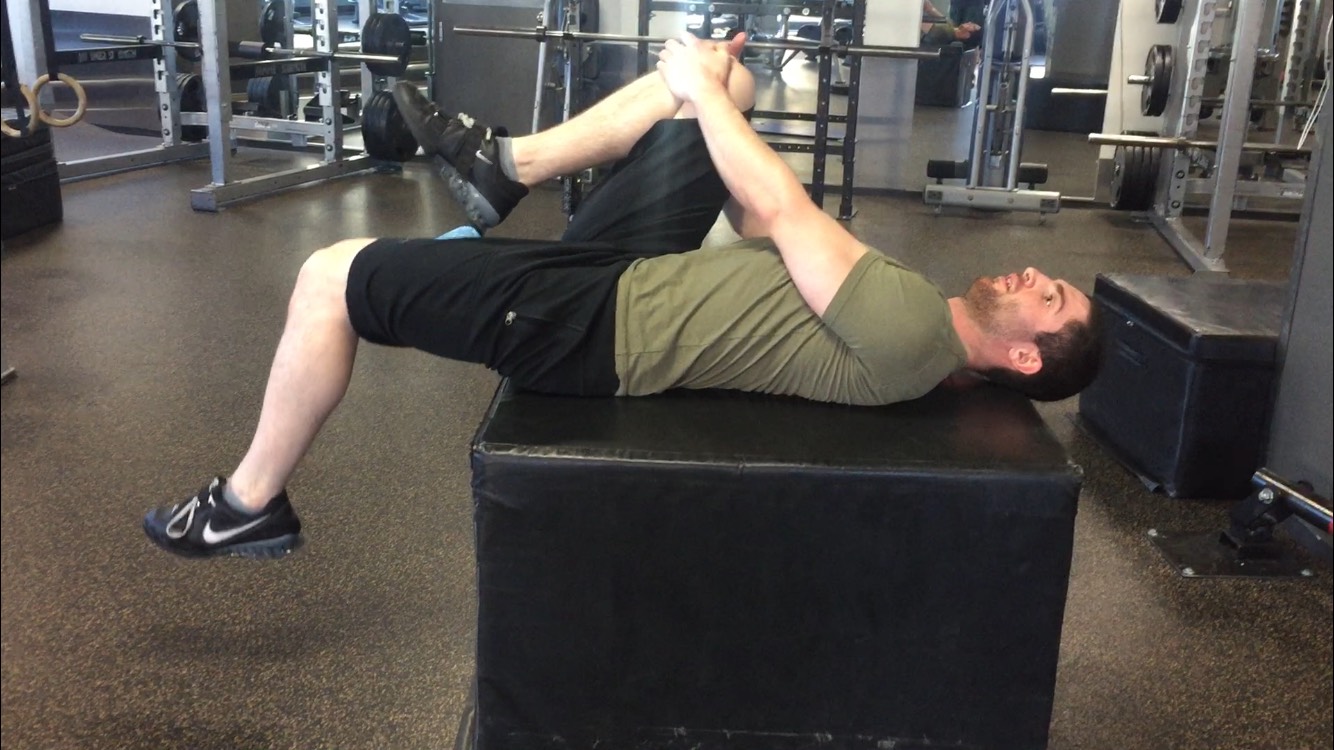
Picture of the Thomas Test — Positive for PSOAS tightness.
The Ober’s Test is a test that indicates tightness in the IT band, the TFL, and partly in the glute medius. The Ober’s Test is performed with the client in a side-lying position on a bed or on the ground with their lower knee and hip slightly flexed. From here, the client’s upper leg (the leg being tested) will be slightly abducted (pulled away from the body) and brought to slight hyperextension. The client’s leg will then be dropped (by adduction) slowly on to the bed. The test is positive for TFL and/or IT band over tightness if the client’s leg is unable to go past the midline of the body without pushing or pain.
Evaluation of the gait cycle can also be used as a diagnosing tool in FAI. Research from 2013 (7) showed that patients exhibiting symptomatic FAI showed less peak hip extension, abduction, and internal rotation during the stance phase. These lower levels of extension, abduction, and internal rotation can be seen potentially by a “sag” from one hip to the other or a difference in force absorption, where one foot takes more pressure than the other during walking (pictured as a classic “swagger” type of walk). Alongside this, patients exhibiting symptomatic FAI were generally shown to take fewer steps per minute during regular walking, which means having symptomatic FAI may slow down a person’s walking speed. (7)
However, as useful as the three previous diagnostic procedures are, the most common and accurate test for diagnosing FAI is the FADDIR (Flexion, Adduction, Internal Rotation) Test. The FADDIR Test is performed by having the client lie face up on a bed or on the ground. From here, the physician or coach will passively move the client’s hip through flexion, adduction, and internal rotation. Pain in the front of the hip indicates a positive test and indicates that the patient tests positive for FAI.
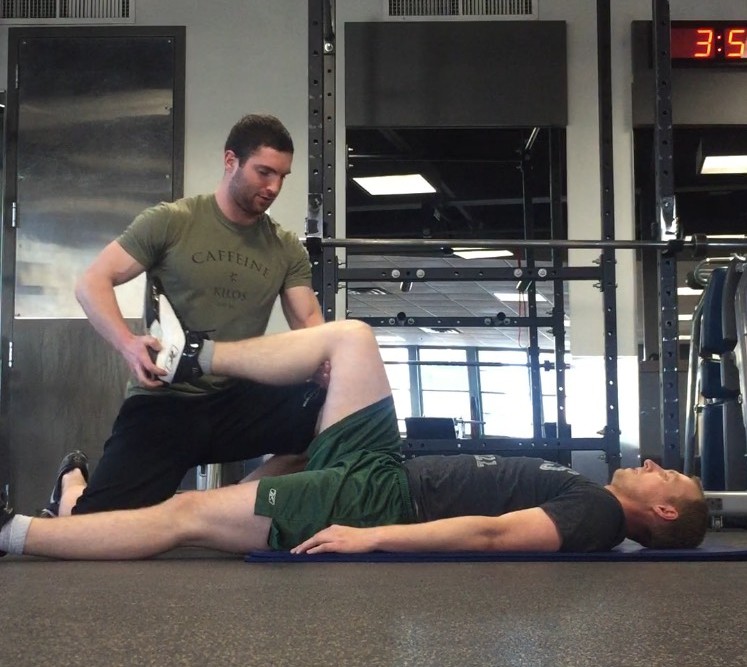
Picture of the FADDIR Test — After flexion, before adduction and internal rotation.
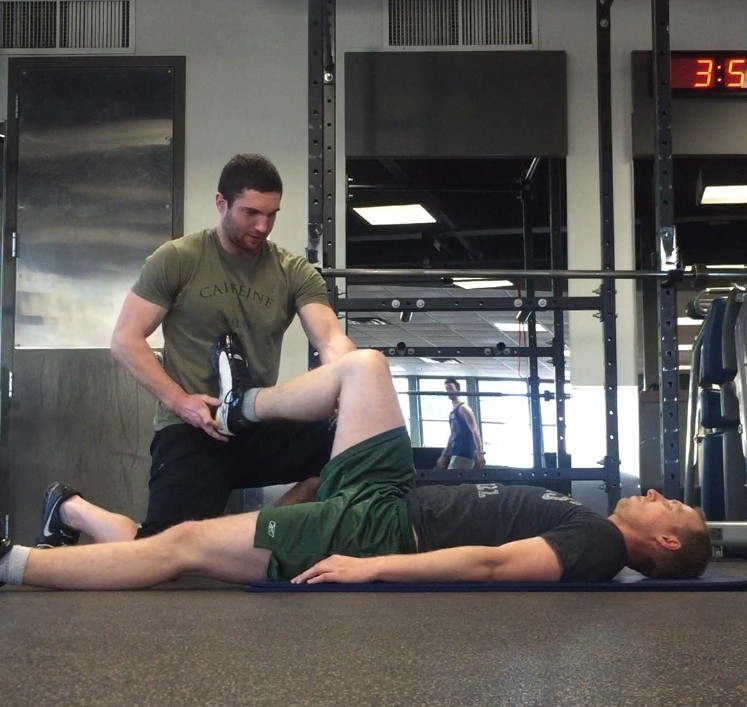
Picture of the FADDIR Test — After flexion, adduction, and internal rotation. Pain indicates a positive test.
It is not uncommon for a person to have zero symptoms indicating FAI during their daily or sporting life but still test positive for the FADDIR Test. As will be described later, it is still important to address this person’s FAI, as it can potentially cause problems later in life. However, for others with symptomatic FAI, the pain can range from being mild and inconveniencing to being extremely movement restricting and painful.
FAI and Sacro-Iliac Joint Pain
Sacro-iliac (SI) joint pain can be caused by FAI and can be a symptom indicating FAI. The cause of sacro-iliac joint pain and why it is affected by FAI will be discussed further in Part 2 of the Femoro-Acetabular Impingement and The Rehab Process series. However, for the purpose of this article, we will go over the symptoms of SI joint pain when caused in relation to FAI.
The symptoms of pain in the SI joint can occur as a dull, aching pain in the side of one’s lower back, during either heavy bracing, hinging forward, lateral bending, trunk rotation, or a combination of more than one of these movements. The SI joint usually occurs on only one side and will be present on the same side as one’s FAI. People can have SI joint pain without the symptoms of FAI at the hip, but having SI joint pain without hip pain is relatively irregular. If this does occur though, similar diagnostic and rehab protocols should be performed.
FAI and Hip Osteoarthritis
Hip osteoarthritis (OA) is a common and sometimes debilitating condition in the elderly and is often found in middle-aged men and women; however, it is more commonly found in women. The cause of osteoarthritis in the hip has been well researched, but there is a multitude of proposed factors that can lead to the development of OA.
Currently, research has shown that cam FAI is a common precursor to having OA at an older age, and given the relatively similar mechanism of each condition, it is assumed by many practitioners that they are heavily related. Pincer impingement has not yet conclusively been shown to be a precursor to OA, but further research may eventually show otherwise. (8)
For this reason (in particular regards to cam impingement), diagnosing and eventually learning how to manage one’s FAI is of utmost importance in regards to the prevention of OA at an older age and should be a more discussed topic in relation to OA, specifically in regards to more conservative non-invasive rehab approaches. (4)
Conclusion
FAI is primarily caused by two different mechanisms, pincer and cam impingement, usually depending on the subject that the impingement is affecting. Cam impingement is most commonly seen in active young males while pincer is most commonly in middle-aged women.
FAI can often be asymptomatic and will not affect some people’s daily lives who test positive to the diagnostic procedures — most notably, the FADDIR test. However, that does not mean that the management of FAI should be ignored, as it may be a factor in hip OA in one’s later life.
The management of symptoms and the issue as a whole is often misunderstood and will be discussed in Parts 2 and 3 of the Femoro-Acetabular Impingement and The Rehab Process series.
References
- Beck M, Kalhor M, Leunig M, et al: Hip morphology influences the pattern of damage to the acetabular cartilage: Femoroacetabular impingementasacauseofearlyosteoarthritisofthehip.JBoneJointSurg Br 87:1012-1018, 200
- Banerjee, P. and Mclean, C.R., 2011. Femoroacetabular impingement: a review of diagnosis and management. Current reviews in musculoskeletal medicine, 4(1), p.23.
- Cobb J, Logishetty K, Davda K, Iranpour F. Cams and pincer impingement are distinct. Not mixed. The acetabular pathomorphology of femoroacetabular impingement. Clin Orthop Relat Res. 2010;468:2143–51.
- Ganz, R., Parvizi, J., Beck, M., Leunig, M., Nötzli, H. and Siebenrock, K.A., 2003. Femoroacetabular impingement: a cause for osteoarthritis of the hip. Clinical Orthopaedics and Related Research®, 417, pp.112-120.
- Peeler, J. and Anderson, J.E., 2007. Reliability of the Thomas test for assessing range of motion about the hip. Physical Therapy in Sport, 8(1), pp.14-21.
- Pierannunzii, L., 2017. Pelvic posture and kinematics in femoroacetabular impingement: a systematic review. Journal of Orthopaedics and Traumatology, 18(3), pp.187-196.
- Hunt, M.A., Gunether, J.R. and Gilbart, M.K., 2013. Kinematic and kinetic differences during walking in patients with and without symptomatic femoroacetabular impingement. Clinical Biomechanics, 28(5), pp.519-523.
- van Klij, P., Heerey, J., Waarsing, J.H. and Agricola, R., 2018. The prevalence of cam and pincer morphology and its association with development of hip osteoarthritis. Journal of Orthopaedic & Sports Physical Therapy, (0), pp.1-25.
Noel FitzGibbon is a former international, underage level weightlifter who has represented Ireland at a European level and has achieved a World Ranking with the IWF. He has coached in strength and conditioning and weightlifting/powerlifting at a provincial, national and international level. He is currently working as a personal trainer and a strength and conditioning coach out of Calgary, Canada.










